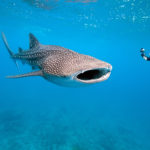Facts about dugongs
 Dugongs like to travel and can swim a distance of about a thousand kilometers, without any apparent reason. They would have swum more, if they had not become victims of collisions with sea vessels and motor boats. Most often they decide on such trips because they lack the necessary amount of feed in their habitat, but they can swim for nothing. Variations in water level or temperature, availability and quantity of food can affect day and seasonal movements.
Dugongs like to travel and can swim a distance of about a thousand kilometers, without any apparent reason. They would have swum more, if they had not become victims of collisions with sea vessels and motor boats. Most often they decide on such trips because they lack the necessary amount of feed in their habitat, but they can swim for nothing. Variations in water level or temperature, availability and quantity of food can affect day and seasonal movements.
Young dugongs often become the prey of large sharks, and this is one of the reasons for a small population. They are easy prey for people. Their meat tastes like veal to taste, fat, bones and skin are also used. And this is the second reason why the dugong is listed in the Red Book, where it has the status of a “vulnerable species”. Bones of dugongs are used for crafts “for ivory” (that’s another similarity with elephants), fat is used in folk medicine.
It is now forbidden to extract dugongs by nets, but is allowed as a traditional fishery for aborigines. Currently, there are about ten thousand individuals, thanks to the measures taken to preserve them, the population does not decrease. But this is a very delicate balance, which can be violated by any ecological catastrophe – for example, the collapse of an oil tanker in the dugong habitat, and poaching.
Dugongs are unique – these are the only existing in our world herbivorous marine mammals. Therefore, the topic of the possible disappearance of the dugong population was considered at the Bonn Convention in the Arab Emirates in 2010, where ways to save dugongs and preserve their populations were discussed.
It was recorded that the economic activities of people – one of the most serious reasons for the decline in the population of dugongs, which in the bay areas recorded about 7 thousand heads. Their pastures are littered with fishing gear, nets and plastic bags. During one of the treatment measures, 1.5 tons of such packages were extracted from the Gulf waters. Reducing the amount of algae as a result of human activity at depths of up to 20 meters – and algae are the basis of nutrition – one of the reasons for the extinction of dugongs.



























